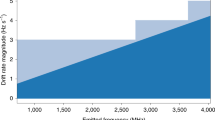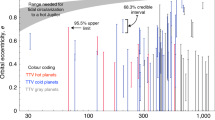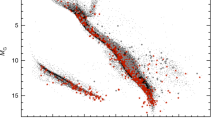Abstract
The goal of the search for extraterrestrial intelligence (SETI) is to quantify the prevalence of technological life beyond Earth via their ‘technosignatures’. One theorized technosignature is narrowband Doppler drifting radio signals. The principal challenge in conducting SETI in the radio domain is developing a generalized technique to reject human radiofrequency interference. Here we present a comprehensive deep-learning-based technosignature search on 820 stellar targets from the Hipparcos catalogue, totalling over 480 h of on-sky data taken with the Robert C. Byrd Green Bank Telescope as part of the Breakthrough Listen initiative. We implement a novel β-convolutional variational autoencoder to identify technosignature candidates in a semi-unsupervised manner while keeping the false-positive rate manageably low, reducing the number of candidate signals by approximately two orders of magnitude compared with previous analyses on the same dataset. Our work also returned eight promising extraterrestrial intelligence signals of interest not previously identified. Re-observations on these targets have so far not resulted in re-detections of signals with similar morphology. This machine-learning approach presents itself as a leading solution in accelerating SETI and other transient research into the age of data-driven astronomy.
This is a preview of subscription content, access via your institution
Access options
Access Nature and 54 other Nature Portfolio journals
Get Nature+, our best-value online-access subscription
$29.99 / 30 days
cancel any time
Subscribe to this journal
Receive 12 digital issues and online access to articles
$119.00 per year
only $9.92 per issue
Buy this article
- Purchase on Springer Link
- Instant access to full article PDF
Prices may be subject to local taxes which are calculated during checkout





Similar content being viewed by others
Data availability
All data used in this paper are stored as high-resolution FILTERBANK and HDF5 format collected and generated from observations by the Robert C. Byrd Green Bank Telescope, which are available through the Breakthrough Listen Open Data Archive at http://seti.berkeley.edu/opendata.
Code availability
The code is available for review at https://github.com/PetchMa/ML_GBT_SETI.
References
Cocconi, G. & Morrison, P. Searching for interstellar communications. Nature 184, 844–846 (1959).
Tarter, J. The search for extraterrestrial intelligence (SETI). Annu. Rev. Astron. Astrophys. 39, 511–548 (2001).
Enriquez, J. E. et al. The Breakthrough Listen search for intelligent life: 1.1–1.9 GHz observations of 692 nearby stars. Astrophys. J. 849, 104 (2017).
Price, D. C. et al. The Breakthrough Listen search for intelligent life: wide-bandwidth digital instrumentation for the CSIRO Parkes 64-m telescope. Publ. Astron. Soc. Aust. 35, E041 (2018).
Price, D. C. et al. The Breakthrough Listen search for intelligent life: observations of 1327 nearby stars over 1.10–3.45 GHz. Astron. J. 159, 86 (2020).
Price, D. C. et al. Expanded capability of the Breakthrough Listen Parkes data recorder for observations with the UWL receiver. Res. Notes AAS 5, 114 (2021).
Enriquez, E. & Price, D. turboSETI: Python-based SETI search algorithm. Astrophysics Source Code Library ascl:1906.006 (2019).
Harp, G. R. et al. Machine vision and deep learning for classification of radio SETI signals. Preprint at https://arxiv.org/abs/1902.02426 (2019).
Zhang, Z.-S. et al. First SETI observations with China’s Five-hundred-meter Aperture Spherical Radio Telescope (FAST). Astrophys. J. 891, 174 (2020).
Pinchuk, P. & Margot, J.-L. A machine learning–based direction-of-origin filter for the identification of radio frequency interference in the search for technosignatures. Astron. J. 163, 76 (2022).
Czech, D., Mishra, A. & Inggs, M. A CNN and LSTM-based approach to classifying transient radio frequency interference. Astron. Comput. 25, 52–57 (2018).
Zhang, Y. G., Hyun Won, K., Son, S. W., Siemion, A. & Croft, S. Self-supervised anomaly detection for narrowband seti. In 2018 IEEE Global Conference on Signal and Information Processing (GlobalSIP) 1114–1118 (IEEE, 2018).
Brzycki, B. et al. Narrow-band signal localization for SETI on noisy synthetic spectrogram data. Publ. Astron. Soc. Pac. 132, 114501 (2020).
Higgins, I. et al. β-VAE: Learning basic visual concepts with a constrained variational framework. In International Conference on Learning Representations (ICLR, 2017).
Kingma, D. P. & Welling, M. Auto-encoding variational Bayes. In 2nd International Conference on Learning Representations (ICLR, 2014); http://arxiv.org/abs/1312.6114v10.8/25
Czech, D. et al. The Breakthrough Listen search for Intelligent Life: MeerKAT target selection. Publ. Astron. Soc. Pac. 133, 064502 (2021).
Hickish, J. et al. Commensal, multi-user observations with an ethernet-based Jansky Very Large Array. Bul. Am. Astron. Soc. 51, 269 (2019).
Siemion, A. et al. Searching for extraterrestrial intelligence with the square kilometre array. In Proceedings of Advancing Astrophysics with the Square Kilometre Array—PoS(AASKA14) (Sissa Medialab, 2015).
LeCun, Y., Haffner, P., Bottou, L. & Bengio, Y. in Shape, Contour and Grouping in Computer Vision: Lecture Notes in Computer Science (eds Forsyth, D. A. et al.) 319–345 (Springer, 1999); https://doi.org/10.1007/3-540-46805-6_19
Snoek, J., Larochelle, H. & Adams, R. P. Practical Bayesian optimization of machine learning algorithms. In Advances in Neural Information Processing Systems 25 (NIPS, 2012).
Abadi, M. et al. TensorFlow: large-scale machine learning on heterogeneous systems (TensorFlow, 2015); https://www.tensorflow.org/
Chollet, F. et al. Keras (Keras, 2015); https://keras.io
Mitchell, T. M. The Need for Biases in Learning Generalizations. Tech. Rep., Rutgers University (1980).
Breiman, L. Random forests. Machine Learning 45, 5–32 (2001).
Virtanen, P. et al. SciPy 1.0: fundamental algorithms for scientific computing in Python. Nat. Methods 17, 261–272 (2020).
LeCun, Y. et al. Backpropagation applied to handwritten zip code recognition. Neural Comput. 1, 541–551 (1989).
Cristianini, N. & Ricci, E. in Encyclopedia of Algorithms (ed, Kao, M.-Y.) 928–932 (Springer, 2008); https://doi.org/10.1007/978-0-387-30162-4_415
Lebofsky, M. et al. The Breakthrough Listen search for intelligent life: public data, formats, reduction, and archiving. Publ. Astron. Soc. Pac. 131, 124505 (2019).
Price, D., Enriquez, J., Chen, Y. & Siebert, M. Blimpy: Breakthrough Listen I/O methods for Python. J. Open Source Softw. 4, 1554 (2019).
Lam, S. K., Pitrou, A. & Seibert, S. Numba: A LLVM-based Python JIT compiler. In Proc. Second Workshop on the LLVM Compiler Infrastructure in HPC, LLVM ’15 1–6 (Association for Computing Machinery, 2015); https://doi.org/10.1145/2833157.2833162
Sochat, V. Singularity compose: orchestration for singularity instances. J. Open Source Softw. 4, 1578 (2019).
Siemion, A. P. V. et al. A 1.1–1.9 GHz SETI survey of the Kepler field. I. A search for narrow-band emission from select targets. Astrophys. J. 767, 94 (2013).
Perryman, M. A. C. et al. The Hipparcos Catalogue. Astron. Astrophys. 500, 501–504 (1997).
Acknowledgements
Breakthrough Listen is managed by the Breakthrough Initiatives, sponsored by the Breakthrough Prize Foundation (http://www.breakthroughinitiatives.org). We are grateful to the staff of the Green Bank Observatory for their help with installation and commissioning of the Breakthrough Listen backend instrument and extensive support during Breakthrough Listen observations. P.X.M. was supported by the Laidlaw foundation, which has funded this project as part of the undergraduate research and leadership funding initiative. S.Z.S. acknowledges that this material is based on work supported by the National Science Foundation MPS-Ascend Postdoctoral Research Fellowship under grant number 2138147. We thank Y. Chen for helpful discussion on the machine-learning framework. P.X.M. thanks L. Doyle and S. Marzen for their kind support, generous guidance and encouragement when he first began his research career.
Author information
Authors and Affiliations
Contributions
P.X.M. designed and led the data analysis under the supervision of C.N. with both of them being primary authors of the manuscript. L.R. led the visualization of the candidate diagnostic plots. A.P.V.S., B.B., D.C., V.G., J.H., I.d.P., D.C.P. and S.Z.S. assisted with interpretation, manuscript preparation and revision, and data analysis. S.C. and H.I. helped with the GBT observations and aided manuscript preparation. M.L. and D.H.E.M. provided instrument support, managed data, and aided observations. J.D. and S.P.W. aided manuscript preparation and provided logistical support.
Corresponding author
Ethics declarations
Competing interests
The authors declare no competing interests.
Peer review
Peer review information
Nature Astronomy thanks Devansh Agarwal, Tong-Jie Zhang and the other, anonymous, reviewer(s) for their contribution to the peer review of this work.
Additional information
Publisher’s note Springer Nature remains neutral with regard to jurisdictional claims in published maps and institutional affiliations.
Supplementary information
Supplementary Information
Supplementary Tables 1–6, Figs. 1–12 and Discussion.
Rights and permissions
Springer Nature or its licensor (e.g. a society or other partner) holds exclusive rights to this article under a publishing agreement with the author(s) or other rightsholder(s); author self-archiving of the accepted manuscript version of this article is solely governed by the terms of such publishing agreement and applicable law.
About this article
Cite this article
Ma, P.X., Ng, C., Rizk, L. et al. A deep-learning search for technosignatures from 820 nearby stars. Nat Astron 7, 492–502 (2023). https://doi.org/10.1038/s41550-022-01872-z
Received:
Accepted:
Published:
Issue Date:
DOI: https://doi.org/10.1038/s41550-022-01872-z
This article is cited by
-
Will an AI be the first to discover alien life?
Nature (2023)
-
Special Issue: Data-Driven Discovery in Geosciences: Opportunities and Challenges
Mathematical Geosciences (2023)



